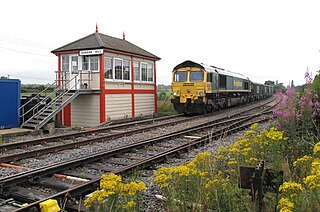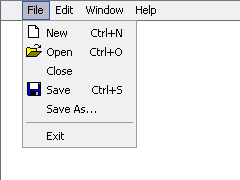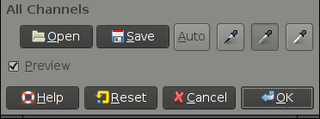XUL, which stands for XML User Interface Language, is a user interface markup language developed by Mozilla. XUL is implemented as an XML dialect, enabling graphical user interfaces to be written in a similar manner to web pages. Such applications must be created using the Mozilla codebase ; the most prominent example is the Firefox web browser.

On a rail transport system, signalling control is the process by which control is exercised over train movements by way of railway signals and block systems to ensure that trains operate safely, over the correct route and to the proper timetable. Signalling control was originally exercised via a decentralised network of control points that were known by a variety of names including signal box, interlocking tower and signal cabin. Currently these decentralised systems are being consolidated into wide scale signalling centres or dispatch offices. Whatever the form, signalling control provides an interface between the human signal operator and the lineside signalling equipment. The technical apparatus used to control switches (points), signals and block systems is called interlocking.

In computing and telecommunications, a menu is a list of options or commands presented to the user of a computer or communications system. A menu may either be a system's entire user interface, or only part of a more complex one.

A checkbox is a GUI widget that permits the user to make a binary choice, i.e. a choice between one of two possible mutually exclusive options. For example, the user may have to answer 'yes' (checked) or 'no' on a simple yes/no question.

Aqua is the graphical user interface and visual theme of Apple's macOS operating system. It was originally based on the theme of water, with droplet-like components and a liberal use of reflection effects and translucency. Its goal is to "incorporate color, depth, translucence, and complex textures into a visually appealing interface" in macOS applications. At its introduction, Steve Jobs noted that "one of the design goals was when you saw it you wanted to lick it".

A control element in a graphical user interface is an element of interaction, such as a button or a scroll bar. Controls are software components that a computer user interacts with through direct manipulation to read or edit information about an application. User interface libraries such as Windows Presentation Foundation, GTK+, and Cocoa, contain a collection of controls and the logic to render these.

A window manager is system software that controls the placement and appearance of windows within a windowing system in a graphical user interface. Most window managers are designed to help provide a desktop environment. They work in conjunction with the underlying graphical system that provides required functionality—support for graphics hardware, pointing devices, and a keyboard, and are often written and created using a widget toolkit.

In computing, the term button refers to any graphical control element that provides the user a simple way to trigger an event, like searching for a query at a search engine, or to interact with dialog boxes, like confirming an action.

A vision mixer is a device used to select between several different video sources and, in some cases, compositing video sources together to create special effects. This is similar to what a mixing console does for audio.

To fast-forward is to move forward through a recording at a speed faster than that at which it would usually be played. The recordings are usually audio, video or computer data. It is colloquially known as 'f-forwarding'. On media controls, such as player buttons and interfaces, the function is commonly represented by two solid arrows pointing right and these typical icons were correctly recognised by 75% of a sample of European consumers. This symbol is represented in unicode as U+23E9⏩.
Tkinter is a Python binding to the Tk GUI toolkit. It is the standard Python interface to the Tk GUI toolkit, and is Python's de facto standard GUI. Tkinter is included with standard Linux, Microsoft Windows and Mac OS X installs of Python.
Dialog Control Language (DCL) is a high-level description language and interpreter within AutoCAD for creating simple graphical dialogs. AutoLISP extensions use it to interact with the user in the AutoCAD environment.
A panel is "a particular arrangement of information grouped together for presentation to users in a window or pop-up". In ISPF, a panel is "a predefined display image that you see on a display screen".
Layout managers are software components used in widget toolkits which have the ability to lay out graphical control elements by their relative positions without using distance units. It is often more natural to define component layouts in this manner than to define their position in pixels or common distance units, so a number of popular widget toolkits include this ability by default. Widget toolkits that provide this function can generally be classified into two groups:
A web widget is a web page or web application that is embedded as an element of a host web page but which is substantially independent of the host page, having limited or no interaction with the host. A web widget commonly provides users of the host page access to resources from another web site, content that the host page may be prevented from accessing itself by the browser's same-origin policy or the content provider's CORS policy. That content includes advertising, sponsored external links (Taboola), user comments (Disqus), social media buttons (Twitter), Facebook), news, and weather (AccuWeather). Some web widgets though serve as user-selectable customizations of the host page itself.

Tk is a free and open-source, cross-platform widget toolkit that provides a library of basic elements of GUI widgets for building a graphical user interface (GUI) in many programming languages.

A mouse button is a microswitch on a computer mouse which can be pressed (“clicked”) to select or interact with an element of a graphical user interface.
Axure RP Pro is a wireframing, rapid prototyping, documentation and specification software tool aimed at web and desktop applications. It offers drag and drop placement, resizing, and formatting of widgets.











